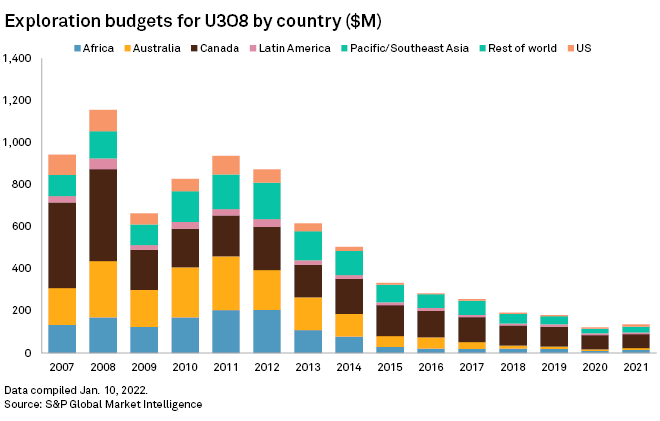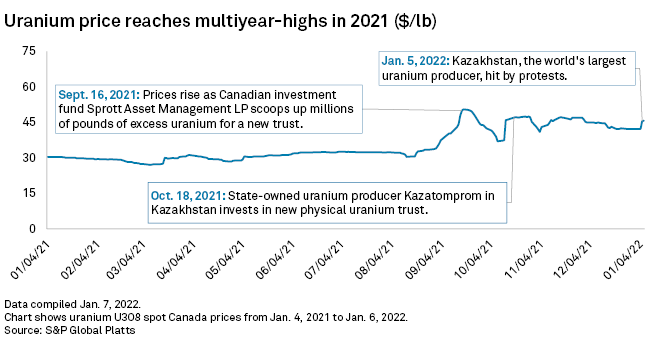S&P Global Offerings
Featured Topics
Featured Products
Events
S&P Global Offerings
Featured Topics
Featured Products
Events
S&P Global Offerings
Featured Topics
Featured Products
Events
Banking & Capital Markets
Economy & Finance
Energy Transition & Sustainability
Technology & Innovation
Podcasts & Newsletters
Banking & Capital Markets
Economy & Finance
Energy Transition & Sustainability
Technology & Innovation
Podcasts & Newsletters
S&P Global Offerings
Featured Topics
Featured Products
Events
13 Jan, 2022
By Camille Erickson

| The Roessing Uranium Mine in Namibia is one of the oldest and largest open uranium mines in the world. Source: Christian Ender/Getty Images News via Getty Images |
Uranium mining companies reversed a 10-year decline in exploration budgets in 2021 and funding is poised to rise further in 2022 as companies aim to capitalize on higher yellowcake prices and a rosier demand outlook.
Uranium exploration budgets rose 10.7% year over year in 2021, with Canada leading the pack and budgeting $67 million, followed by the U.S. at $10.1 million, according to S&P Global Capital IQ data. Globally, uranium exploration budgets for juniors reached about $94.3 million in 2021, while majors' exploration budgets for uranium totaled approximately $22.7 million, an S&P Global Market Intelligence analysis found.
The global exploration budget remains far from peaks seen in the late 2000s, but even modest increases represent new hope for the moribund industry. Prices rose to the mid-$40s per pound in 2021, more than double the lows around $20/lb in 2017 and 2018. Buying activity from a Canadian investment fund and instability in Kazakhstan, the world's largest producer of yellowcake, has driven up prices, motivating some companies to seek out new supply, especially in politically stable countries. Prices need to clear $50/lb before anyone will engage in significant production at new sites. But with forecasters predicting increases well above that benchmark, junior companies, especially, have gone out uranium hunting.
"Things are just very hot right now on the exploration side," said Sid Rajeev, vice president and research director at Fundamental Research Corp.

In 2021, uranium prices ended a yearslong slide that dated back to the days following the 2011 Fukushima Dai-ichi reactor disaster in Japan, which chilled global interest in nuclear power. Toronto-based investment fund Sprott Asset Management LP, a subsidiary of Sprott Inc., shocked the global uranium market by buying up millions of pounds of excess supply for a new trust in the summer of 2021. Prices rallied on Sprott's buying, and they promised to stay high as the fund's managers said they had no plans to sell their commodity, effectively taking it off the market. On Oct. 18, Kazakhstan's state-owned uranium company, Kazatomprom, announced it too would invest in a physical uranium fund, called ANU Energy OEIC Ltd.
After a near-decade of oversupply, the uranium market significantly tightened. At the same time, the demand picture is "really, really strong," said Katie Lachapelle, an equity research analyst focused on uranium at Canaccord Genuity Corp.
Seeking lower-carbon power sources to meet new emission targets, governments and utilities have started eyeing the potential of nuclear energy again. Some countries, including France and the U.K., have committed to expanding their nuclear fleets to produce carbon-free electricity and meet climate objectives espoused at the most recent COP26 climate conference.
Rising demand along with fund buying activities helped uranium prices sail over $46/lb in 2021, a high not seen since 2012 as prices began to fall. Companies hope to take advantage of those rising prices.
"You're seeing a lot of these advanced stage developers and explorers, especially over the last year, increase their budgets," Lachapelle said in an interview.

"Especially last year, we saw a huge increase in junior miner exploration with a lot of money flowing into these companies," Jonathan Hinze, president of UxC LLC, a leading uranium research and analysis firm, said in an interview. "In some cases, their equity prices jumped 20% or 30%. They were able to raise money. There's clearly a number of producers in different regions — Canada, U.S., some parts of Africa and Australia — where there's been a real uptick in activity."
Recent unrest in Kazakhstan is driving interest in diversifying sources of uranium, especially in places with stable governments and infrastructure. That benefits explorers in Canada and the U.S., helping them attract investment dollars.
That bodes well for rising exploration budgets going into next year.
"Given the continuing trends in the industry, I believe there are likely to be additional increases in uranium mine exploration and development activity in 2022," Hinze said in an email. "The most likely focus areas for new development are going to be in the Athabasca Basin in Saskatchewan as well as several regions in Africa and Australia."
Not there yet
Still, it will likely take a price of at least $50/lb for most uranium developers to advance projects into production, according to multiple analysts. It is a price that even Sprott's flurry of activity has not allowed the market to reach. S&P Global Platts assessed the month spot price of U3O8 to Canada at $45.75/lb on Jan. 6.
"The first leg of projects that will come online will probably be restarts," Lachapelle said, citing existing mines operated by uranium heavyweights such as Cameco Corp. "But I would still argue that these projects are looking for prices north of $45/lb, more around the $50/lb range."
In the later part of the decade, advanced stage development projects could start entering the market, but those are often more capital intensive.
"Our long-term price forecast is $65/lb," Lachapelle said.
Optimistic outlook
Junior uranium developer Blue Sky Energy Inc. has been gradually increasing its exploration budget over the past five years, and has made multiple discoveries over the past 15 years, said Guillermo Pensado, Blue Sky's vice president of exploration and development. The company has undertaken what it called an "aggressive exploration program" in southern Argentina at its Amarillo Grande project, which consists of three properties.
For its part, Blue Sky aims to find a company to begin production at its Amarillo Grande project soon to meet the growing need.
"We are seeing the chance to bring in a well-experienced production company in uranium or a good buyer," Pensado said in an interview.
The International Energy Agency expects global nuclear capacity to reach 582 GW by 2040, up from the 415 GW recorded in 2020, according to a report released in November 2021.
Several major uranium companies headquartered in North America, including Cameco Corp.and Energy Fuels Corp., announced in January that they could reopen mines and mills in the wake of higher demand. Yet, adding any fresh supply sources to the world market will take time.
"Uranium mines don't happen overnight. It takes five to 10 years in many cases for projects to go from a greenfield site through to an actual operating mine," said Hinze of UxC LLC. "There's a lot of folks that are trying to get into that pipeline."
S&P Global Platts and S&P Global Market Intelligence are owned by S&P Global Inc.
